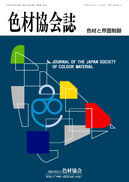All issues

Predecessor
Volume 87, Issue 4
Displaying 1-5 of 5 articles from this issue
- |<
- <
- 1
- >
- >|
Original Research Paper
-
Shinya IIZUKA, Kazuhide MURATA, Masahiro SEKINE, Chiaki SATO2014 Volume 87 Issue 4 Pages 114-117
Published: April 20, 2014
Released on J-STAGE: July 20, 2014
JOURNAL FREE ACCESSA method for measuring the water vapor transmission rates of materials whose thin films are difficult to prepare is presented in this work. The method enables us to treat materials such as paints and adhesives, which are laminated on a cellulose triacetate film having a high permeability of water vapor and a high surface smoothness. The total permeability of a laminate is measured by the cup method and the permeability of the objective material is calculated by means of compensating the vapor transmission in the cellulose triacetate film. The predicted value of permeability for the objective material showed a good correlation with the value measured with a free membrane of the material.View full abstractDownload PDF (843K)
Current Topics
-
Yuta MATSUSHIMA2014 Volume 87 Issue 4 Pages 118-123
Published: April 20, 2014
Released on J-STAGE: July 20, 2014
JOURNAL FREE ACCESSRare-earth-free phosphors based on vanadate compounds are described in this review paper. Rare-earths are used in the luminescent centers in various commercial inorganic phosphors and their constituents, as well as critical additives in other functional materials such as neodymium magnets and hydrogen storage alloys. Although exhaustion of the resources is not expected to occur in the near future, the steady supply has been affected by the absence of high-content ores. The high-cost for deduction from ores, refinement and purification is also a problem of rare-earths. A material design based on a rare-earth-free concept should therefore be considered a key technology for realization of a sustainably developing society. Although it is known that some vanadate compounds show photoluminescence under irradiation of ultra-violet (UV) light, the origin of the difference in the colors according to the compositions had not been clarified. We have recently reported several vanadate phosphors such as Sr2VO4Cl (deep-blue), Ca2VO4Cl (sky-blue), Ba2V2O7 (green) and Zn3(VO4)2 (yellow) and found an inverse correlation between the luminescent energies and the V-O distances in the VO4 tetrahedra. Reddish luminescence was attained by reducing the electrostatic interaction between V5+ and Xn– (X: anion) with vanadium oxyfluorides, which is not obtained with oxide vanadate compounds.View full abstractDownload PDF (2057K)
Review
-
Syuji FUJII, Yoshinobu NAKAMURA2014 Volume 87 Issue 4 Pages 124-130
Published: April 20, 2014
Released on J-STAGE: July 20, 2014
JOURNAL FREE ACCESSConducting polymers have attracted much interest, due to the increasing applicability as electrolytic capacitor, battery electrode and rust inhibitor. Although the simplest method for the synthesis of conducting polymer is chemical oxidative precipitation polymerization, the resulting polymer is highly aggregated and therefore unsatisfactory for most applications. The synthesis of conducting polymer in colloidal form is one of the attractive alternatives to overcome its poor processability due to its insolubility in common organic solvents and water. This article presents an overview of research activities that center on synthesis of conducting polymers in a form of colloidal particles by chemical oxidative polymerization.View full abstractDownload PDF (3213K)
Serial Lecture
-
Chemisorption(2)Yasushige KURODA2014 Volume 87 Issue 4 Pages 131-138
Published: April 20, 2014
Released on J-STAGE: July 20, 2014
JOURNAL FREE ACCESSIt is well known that powdered solid-inorganic compounds play pivotal roles in industrial and environmental processes as catalysts and adsorbents. From such viewpoints, it is important to clarify the surface states of such materials to design more efficient materials working in these processes. In this comment, fundamental analysis methods of the active species formed on powdered solid materials are firstly explained on the basis of energetic, structural and electronic viewpoints. In the succeeding section, the specific properties caused by the metal-ions exchanged in zeolites are described: the strong N2 adsorption on the monovalent copper ion formed in the MFI-type zeolite (abbreviated as MFI), Xe reacted species with the monovalent copper ion in MFI, and the formation of novel atomic zinc species as well as the monovalent zinc ion through the H2 activation on ZnMFI.View full abstractDownload PDF (2854K)
-
Current Status of Adhesion Technology and Outline of Highly Reliable Bonding(1)Kosuke HARAGA2014 Volume 87 Issue 4 Pages 139-144
Published: April 20, 2014
Released on J-STAGE: July 20, 2014
JOURNAL FREE ACCESSThe current status of adhesion technology, the concepts and guidelines for reliable bonding and design criteria are presented. It is important that the cohesive fracture rate is adjusted to 40%or more and the coefficient of variance of the bonding properties is adjusted to 0.10 or less. Durability is not a given property but a produced one. Combined joints are effective in the development of reliable systems.View full abstractDownload PDF (2503K)
- |<
- <
- 1
- >
- >|